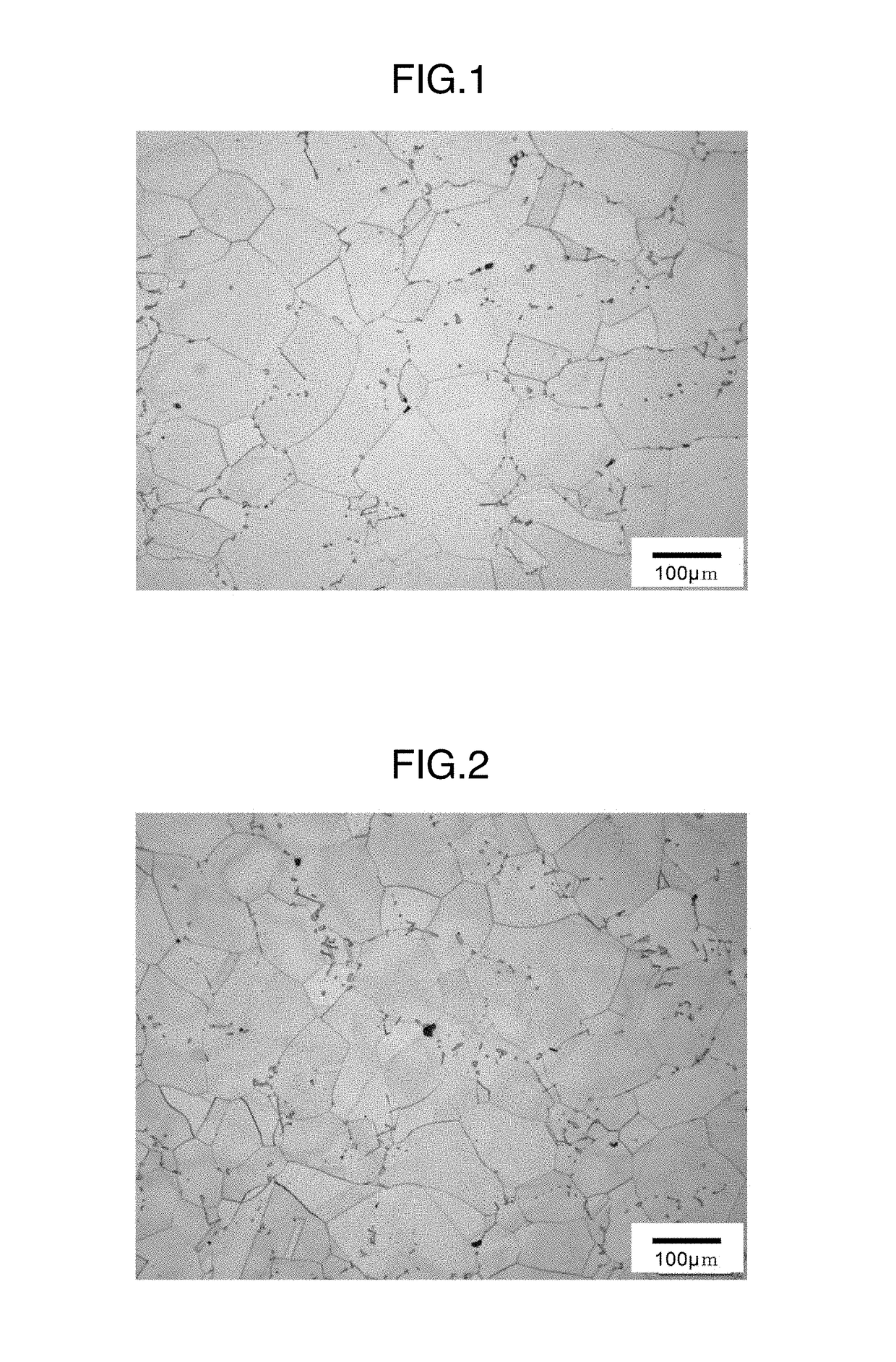Method for manufacturing Ni-based super-heat-resistant alloy
a super alloy and ni-based technology, applied in the field of ni-based super alloy production, can solve the problems of high production cost, complex comparison of process, and inability to apply components that are required, and achieve the effects of reducing production cost, preventing contamination of impurities, and reducing dynamic properties and reliability
- Summary
- Abstract
- Description
- Claims
- Application Information
AI Technical Summary
Benefits of technology
Problems solved by technology
Method used
Image
Examples
example 1
[0082]The present invention will be described in more detail by way of following Examples.
[0083]A Ni-based heat-resistant super alloy was melted under vacuum, and an ingot (ϕ 40 mm*200 mmL) of a Ni-based super alloy A was prepared by lost wax precision casting. A chemical composition of the alloy A is shown in Table 1. In principal, an amount of γ′ phase that can precipitate in an equilibrium state and a γ′ solvus temperature of the Ni-based super alloy is determined by an alloy composition. The γ′ solvus temperature and γ′ molar ratio of the alloy A were calculated with use of commercially available calculation software JMatPro (Version 8.0.1, a product manufactured by Sente Software Ltd.). As a result, it was obtained that the γ′ solvus temperature was 1188° C. and the γ′ mol ratio at 700° C. was 69%.
[0084]From the ingot of the alloy A, a sample of ϕ 13 mm*100 mmL was taken for a compression test in a direction parallel to a longitudinal direction of the ingot.
[0085]
TABLE 1(mass %...
example 2
[0101]A Ni-based heat-resistant super alloy was melted under vacuum, and an ingot (ϕ 100 mm*110 mmL) of a Ni-based super alloy B was prepared. A chemical composition of the alloy B is shown in Table 3. A γ′ solvus temperature and a γ′ molar ratio of the alloy B were calculated with use of the commercially available calculation software JMatPro. As a result, it was obtained that the γ′ solvus temperature was 1162° C. and the γ′ mol % at 700° C. was 46%.
[0102]From a ¼ diameter position of the produced ingot of the alloy B, a sample of ϕ 22 mm*55 mmL for a compression test was taken in a direction parallel to an axial direction of the ingot.
[0103]
TABLE 3(mass %)CCrMoWCoAlTiNbFeZrB0.019315.723.021.2115.042.584.960.010.0310.013* The balance is Ni and inevitable impurities.
[0104]As the first cold working, an upsetting working was applied to a round bar of ϕ 22 mm×55 mmL in the axial direction, and the cold working was conducted at a working ratio of 10%. The working ratio was calculated b...
example 3
[0110]A Ni-based heat-resistant super alloy was melted under vacuum, and an ingot (ϕ 100 mm*110 mmL) of a Ni-based super alloy C was prepared. A chemical composition of the alloy C is shown in Table 4. A γ′ solvus temperature and a γ′ molar ratio of the alloy C were calculated with use of the commercially available calculation software JMatPro. As a result, it was obtained that the γ′ solvus temperature was 1235° C. and the γ′ mol % was 72%.
[0111]From a ¼ diameter position of the produced ingot of the alloy C, a sample of ϕ 22 mm*55 mmL for a compression test was taken in a direction parallel to an axial direction of the ingot.
[0112]
TABLE 4(mass %)CCrMoVCoAlTiNbFeZrB0.01499.802.930.6715.125.484.550.100.0460.013* The balance is Ni and inevitable impurities.
[0113]As the first cold working, an upsetting working was applied to a round bar of ϕ 22 mm×55 mmL in the axial direction, and the cold working was conducted at a working ratio of 10%. The working ratio was calculated by the above ...
PUM
| Property | Measurement | Unit |
|---|---|---|
| temperature | aaaaa | aaaaa |
| temperature | aaaaa | aaaaa |
| temperature | aaaaa | aaaaa |
Abstract
Description
Claims
Application Information
 Login to View More
Login to View More - R&D
- Intellectual Property
- Life Sciences
- Materials
- Tech Scout
- Unparalleled Data Quality
- Higher Quality Content
- 60% Fewer Hallucinations
Browse by: Latest US Patents, China's latest patents, Technical Efficacy Thesaurus, Application Domain, Technology Topic, Popular Technical Reports.
© 2025 PatSnap. All rights reserved.Legal|Privacy policy|Modern Slavery Act Transparency Statement|Sitemap|About US| Contact US: help@patsnap.com



